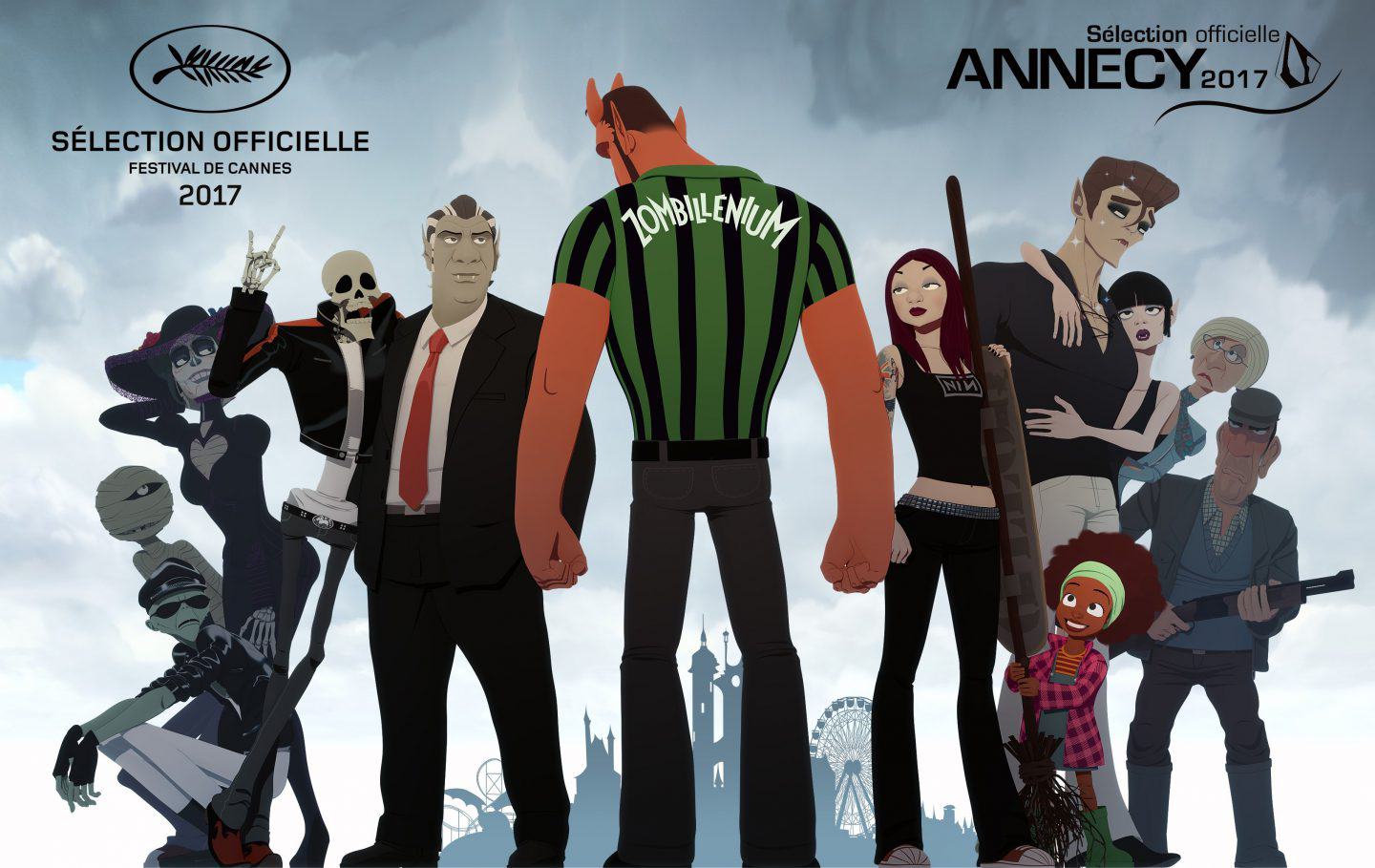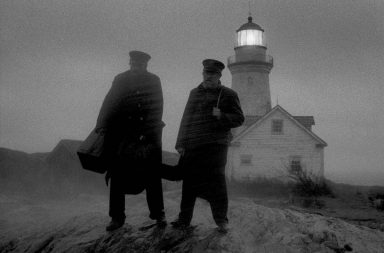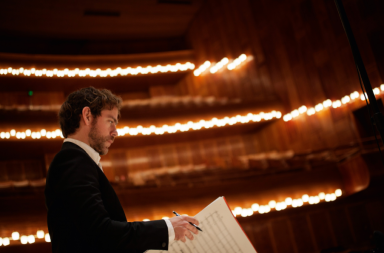From the stage to the screen, from comedy to crime, Eric Neveux truly is a master of all trades. The incredibly versatile French composer got his start in the music industry at a young age, working with director François Ozon on his first two films Regarde La Mer and Sitcom.
Since then, the L.A based composer has created original music for over 55 feature films as well as a number of scores for TV films and series. His work includes independent films such as Just Like a Woman (2013), starring Sienna Miller, and the 2015 Cannes Film Festival opening film, Emmanuelle Bercot’s Standing Tall. Neveux further extends his compositional prowess to more popular films such as Nicholas on Holiday by Laurent Tirard and the hit TV series Borgia.
Today, Score It talks to the wonderful Eric Neveux about his latest work on the animated thrill-ride that is Zombillenium. In creating the score for this feature film, Neuveux collaborated with Mat Bastard, ex-leader of rock band Skip the Use, who was instrumental in the creation of the rock musical theme that permeate the film.
Adapted from the hit graphic novel by French cartoonist Arthur de Pins and his co-director Alexis Ducord, Zombillenium is the story of a Halloween theme park where real monsters can hide in plain sight. The collection of misfit monsters range from demons to werewolfs, from vampires to zombies. The most monstrous part, they are damned to work in the park for all eternity. Everything changes when Hector, a human being, threatens to close down the park.
Can you tell a bit about your musical journey? What led you to becoming a film composer?
I’ve always wanted to be a composer, and pretty quickly, I knew that I wanted to compose over moving images. I can’t remember wanting to be anything else when I was little. It was the only thing that ever really interested me. Ironically, I never studied music. I went to the local music school when I was little, where I played piano. I was terrible though, I was awful at music theory and was definitely not built to study classic music.
When I was 10 or 11 I joined a school that had, at the time, a very famous children’s choir – Les Petits Chanteurs de Chaillot. This choir built up young children for careers in the opera, for the few roles that children could have, for example the roles in the Magic Flute. I joined the choir as an alto. For two years I lived in what seemed to be a sort of paradise on earth; I went to class during the day and at night I sang with the choir. I became a soloist alto. The summer of Year 8 the choir took me on a tour to the USA. 35 years later, when I moved to LA with my family, I remembered that since that tour I had told myself that one day, I’d spend some real time in the US.
There was also a very professional aspect to filming with the choir; we sang on television, on the radio, we were touring artists! It was then that I realised that I wanted music to become a career. All around me, people told me that music was more of a hobby, which was obviously quite frustrating for me as I was looking into it as a very realistic career path.
My music theory standard started to improve – my piano skills, however, did not. Soon after I had to stop singing because my voice broke – puberty really is a pain! Two or three years later I told my parents that I was going to stop going to the local music school and start playing piano several hours a day. I wasn’t really an autodidact because I did have a grasp on the basics but I worked in a relatively autonomous way. As a child, I was passionate about electronic music and I always dreamed of having a synthesizer.
Against all odds, I finally got a degree from business school in Lyon. It is then that I started to really focus on making music. When I was a student, I bought myself a Mac and I immediately downloaded music softwares and started programming. It was pretty much all I did. I then found a job in a record shop. I worked for just over two years as an assistant to Charles-Henri de Pierrefeu – the music advisor for film scores at Polygram (now Universal). I learnt everything I know there. I found myself in editing suites with directors – most notably Mathieu Kassovitz, who had just made La Haine, Maurice Pialat, Arnaud Desplechin, Laetitia Masson; all the directors of the mid/end of the 90s who were fundamental in creating a prolific period in French cinema.
Charles-Henri de Pierrefeu was my mentor but he was a long way from being called a musician. He was a musical encyclopaedia. He was not interested in creating scores as he was a consultant on the songs. Through him I learnt many things about the relationship between music and the image.
In 1995, I met François Ozon who was leaving FEMIS (an internationally renowned film school) and we made two films together. At this time, I also met Patrice Chéreau, and it was then that everything fell into place. Patrice became a very important person for me, a sort of spiritual father. I then left Polygram to start creating my own music. My first scores started in 1997/1998 and they haven’t stopped since.
Would you say you are a cinephile?
In my family, we liked films but we were never obsessed with cinema. I’m quite a cinephile, I created my own cinematic culture, mostly by working with Charles-Henri de Pierrefeu. I could see films that were in pre-production, film premieres, everything. I loved the atmosphere in the editing room, at the time films were still made in 35mm.
At the same time I started using samplers, this was right at the start of electronic music. I don’t come directly from the techno scene but I found myself, a bit randomly, being signed onto the Bristolian label Cup of Tea Records. I found myself with a British band and I finally had my start in the film music industry from an electronic angle.
What film composers do you regard as your biggest source of inspiration?
I didn’t have a large background knowledge of composers but I had some fundamental shocks when I was very young, one of them was Ennio Morricone. When I ask myself questions, mostly about the eccentric side of film music, I always turn towards his work. It allows me to see music from a new point of view, with ‘fresh ears’, and look for the unexpected angle with which to tackle the scene.
Now, let’s talk a bit about Zombillemnium: did you know the comic before joining this project?
Not at all. My grandpa was a big fan of Franco-Belgian comics and I am an avid comic and graphic novel reader. I always wanted to do an animated movie and Emmanuel Deletang let me do two – A Stork’s Journey and Zombillenium, for which he was the music producer. In the winter of 2016, we bumped into each other when I was in Paris working on Cézanne et Moi. He talked to me about this film that was in production. It was there that I was able to meet the comic book creator and co-director of the film, Arthur de Pins, and Claire La Combe (the production supervisor). The animation was done in La Réunion by the production team Pipangaï. Co-director Alexis Ducord and Henri Magalon were also in attendance. The five of us had a big Skype meeting to talk about the project at hand. They had already had numerous discussions with Mat Bastard about the songs and needed an original score composer. I got along very quickly with Arthur and he gave me some of his comics which I absolutely loved, much like my 12-year-old daughter who couldn’t put them down either! I was given a few images and got to work right after Christmas 2016 and we recorded everything in March 2017. There is a lot of long distance work in animation because the production process is often off-kilter. We shared documents and had a lot of Skype meetings.
How do you really work on an animated movie? You had images but did you any have animated sequences?
I was shown summative scenes with rather basic sounds. The real difference between live action and animation films is that in animation, there is no real sound besides the voices.
With a traditional feature film, I work a lot with direct sounds. I like music to find its place in the sound spectrum of the film. In animation, the sound spectrum is very empty before the sound editors arrive. We sometimes have the impression that we have to fill in every silence because there is nothing else there, but that’s the real trap, overfilling. Through A Stork’s Journey and Zombillenium, I learnt not to overcompensate on creating the sounds that weren’t there.
The amount of music in this film is indeed, pretty substantial.
Yes, it’s a very musical film which slightly follows the American wall-to-wall style. As well as this, there is another level to the music in this film, most notably Mat Bastard’s rock music – particularly in the concert scene. The spotting of the film said, “there is music almost everywhere”. We took some out but it is true, there really is very little silence in the film, particularly in the last 20 minutes. We did, indeed, follow the American animation style with music that projects itself throughout the film. It does, however, makes sense in this scenario; the story is happening in a theme park, it’s a very loud and atmospheric environment.
You talked about the role of rock in the film. Did the gothic universe of the comic book lead you to incorporating drum sets and electric guitars? The gothic aesthetic does naturally pair with rock music – as seen in artists like The Cure or Marilyn Manson.
Yes indeed, it did come quite naturally. I also came from quite a rock, electro, pop background rather than classical, so for me it was quite natural to integrate those elements in the composition process. I didn’t want to be in competition with Mat’s songs but rather prolong the moments of energy that his songs created through the score and then subtly move onto something more orchestral. But there are, indeed, some pure rock songs like in the car chase scene. What defines this score for me, is the kind of textural hybridity. There is a mixture of orchestral, drums, guitars and synths. It is a mixture of the comic book’s aesthetic and the directors’ and the producers’ universe. We were all in a rock and roll mind-set for this film!
I recorded the score in Los Angeles, where I had access to many rock musicians, most notably Scott Seiver, Jack White’s drummer who is working with John Carpenter, amongst many others at the moment. In the US, people are more used to this mix of genres, there is no problem putting a drummer in the middle of an orchestra. I am very proud of my work for Zombillenium because of this hybridity, it totality syncs with the film’s identity. I drew upon my experiences in London where I worked on Les aventures de Spirou et Fantasio. When I was there we had an orchestra that created the score on a 180-bpm drum-set, that played some funky stuff. I feel that Anglo-Saxons have an interesting musical culture; while they may be seasoned classical musicians, most have an internalised pop culture sound, and thus there is less of a pop/classical division and categorization. The borders between the genres are more confused and unclear, it’s very exciting to work with them!
Moving back to Mat Bastard and the songs he composed for Zombillenium, did you collaborate?
The songs were created almost two or three years ago. Mat was there right from the start, as he was also playing a character and had concert scenes. His songs were basically the film’s starting point! When I arrived, all this was already finished a long time ago. We met each other at Cannes this year when the film was shown and we got to know each other during the Annecy International Animation Film Festival. I really liked his music, like I said, it really influenced the way I approached the score. I wanted my score to work with his songs and not overshadow them. I wanted my score to become more ‘classical’ but that there was still continuity. I think that is something we managed to do successfully. It would have been very clumsy to come in and mess with the sounds he had already put in place.
Apart from the differences we talked about earlier, do you find there are many significant differences in the way people work on a French film to that of an international film?
I really like the Anglo-Saxon approach to film music. The fact that they have music editors, for example, it’s something that is really missing in France. While working on Borgia, where we had a music editor, I learnt to what extent it was important to have an intermediary between the composer and the editing/mixing for music manipulation and the re-editing, etc. When I work on a French film, I make sure I have a music editor in my team because they are completely necessary in optimising the final cut of the soundtrack.
The goal here isn’t to add more music, I’m talking about the manipulation and optimisation of the music that is already in the film.
You have worked for a really wide range of genre and arts (from cinema to the theatre), navigating between them with great ease. Are you a chameleon composer?
I don’t like the term chameleon. If you take Morricone, who I mentioned at the start of this interview, and look at the things I love about his film music, there is a lot of variety. I found myself, at the very start of my career, working with Patrice Chéreau and Francois Ozon, going from popular movies to arthouse films. I went from one film to another embracing the change in style and genre. Morricone’s work is a brilliant example of variety. His scores, more specifically those he made in the 60/70s, are iconoclastic.
What I kept from this is to make sure you are retaining and establishing your personal style as an artist as well as exploring new territories. Comedy is, without a shadow of a doubt, the hardest genre to tackle: you have to keep sounds effective without disconnecting from musicality – otherwise known as the ‘mickeymousing’ trap. It’s a real challenge because there is a rhythm to it. Indeed, there is very strong and sensitive interaction between the comedy and the music. I would have felt irritated if my music was labeled into one genre or another, or one style or another. I’ve worked in over a hundred projects and today, especially thanks to my American agent, I’ve realised that I do want to target certain types of films.
And what type of films would interest you?
I definitely want to continue my work in animation. It’s really dynamic and stimulating. We can switch really rapidly from one emotion to another, the tempo is really fast because the timeline of an animation film is surreal. This is mostly due to the fact that animation is often targeted at a younger audience and works on a very different beat to that of live action. I equally would like to go back to what I initially started to work on: hybrid scores, the mixture of electronic music. I also hope to be lucky enough to work with minimalist scores. I mean, I say this now, but in 3 weeks someone might offer me a film with a full orchestra and I’d be delighted. But this eclecticism, that’s not to mean I am some sort of jukebox or chameleon. I forbid myself from doing certain things: I refuse to make music that is ‘made for the radio’ and writing songs, that’s a whole other science. Even if I am offered something very well known, whatever the case may be, I’d try and put my own mark on it.
Can you tell us a bit about any future projects you may have?
I just finished Les aventures de Spirou et Fantasio by Alexandre Coffre, who I had previously worked with on his first full length feature film, Une pure affaire. This film is an adventure comedy, it’s very rhythmic, and I made a score to match. It’s a very pop-y score with a little wink to the 60s and lots of drums and groovy percussions. We recorded the pop parts in L.A., where I once again called upon Scott Seiver. The strings were recorded in London, in a very Swinging London style. Now, I’m about to start Belleville Cop, the new Rachid Bouchareb film, who I’ve worked with a few times now. It’s an adventure thriller, a buddy movie. Omar Sy plays a French cop from Belleville who finds himself forced to collaborate with a Latino cop (played by Luis Guzmán) in Florida on a drug trafficking case. Rachid Bouchareb often speaks of living together in his movies and here he took great pleasure in putting all these people from different backgrounds together for an action movie, a genre which he is new to. It’s a great script.
Interview prepared, conducted and transcribed by Marine Wong Kwok Chuen.
Translated by Priya Matharu
Edited by Valentin Maniglia





